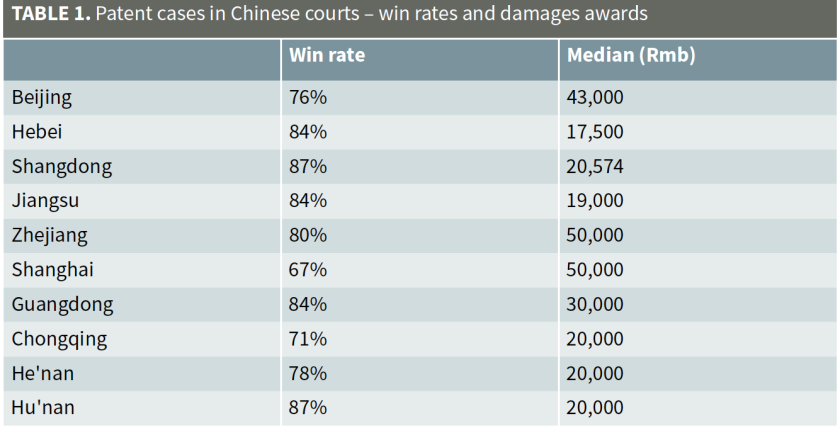A few years ago a company whose patents were violated in China had little or no chance of defending its rights.
Determined to move beyond its role as a low-cost provider of look-alike consumer products, and establish itself as an innovation leader, China has learned from the successes – and mistakes – of other intellectual property systems, especially the U.S. The nation of 1.4 billion inhabitants has rapidly emerged as what is currently among the fairest and most patent holder-friendly systems in the world.
Chinese patent courts second only, perhaps, to Germany in quickly and fairly adjudicating disputes.
A fascinating article in the current IAM magazine, “Defending a patent case in the brave new world of Chinese patent litigation,” details China’s rapid rise from low-cost copier to a patent power, and a nation that has caught the attention of major global technology powers who are often defendants.
Damages awards are relatively small in China, with median awards currently around 35,000 Renminbi or about $5,000, but injunctions, the power to stop a likely infringing product from being sold, are now issued over 99% of the time to winning parties. NPEs, what some U.S. companies refer to as patent “trolls,” are treated fairly as long as they their patents are of sufficient quality and are the companies are generally supportive of Chinese welfare.
__________
Patent litigation win rates, according to the article, average around 80%. Startlingly, foreign plaintiffs fare better statistically than Chinese.
__________
The U.S. effectively ended the granting of patent injunctions in 2006 with EBay v. MercExchange. Now, only operating companies can obtain them in rare circumstances. This removes most of the leverage afforded patent holders. Granted, injunction abuses are a fact of life, and dubious patents have at times been used to enjoin products, costing companies time and money. But without the power to stop a product from being sold, patents have little meaning.
Race to the Bottom
“Largely as a result of the United States’ race to the bottom in terms of patent enforcement, Germany has emerged as a go-to patent jurisdiction, with virtually guaranteed injunctions, quick time to trial and no discovery resulting in a highly efficient system,” writes Beijing-based Erick Robinson, chief patent counsel, Asia-Pacific for Rouse, a global IP strategy firm.
Patent-holder Win-Rates and Median Damages Awards
“Enter China. For years the laughing-stock of all things IP related, the Middle Kingdom was ridiculed for the easy availability of counterfeit handbags, software and DVDs. However, over the last 15 years, and especially in the last two to three, China has put together an extremely effective patent enforcement system. Based largely on the German system and all of its advantages, but with selected portions from US law, China has now become a top forum for patent litigation.”
Unlike most countries which enjoin making, using and selling allegedly infringed products in-country, as well as imports, Chinese law also bans infringing exports from leaving the country. So, for example, if the accused device is Apple’s iPhone, not only can sales of iPhones in China be enjoined, but also exports of the devices from China. This would enable a patent owner to achieve an effective worldwide ban, since iPhones are manufactured in China.
Slippery Slope
With U.S. patent protection significantly diminished over the past decade, and China’s on the rise, the U.S. is on a slippery slope when it comes to stimulating R&D, innovation and investment. It is well on its way to becoming a second-rate patent system, and a slip in disruptive innovation, necessary for the creation of new industries, difficult to measure in real-time, has probably started. Certainly, companies and their stakeholders are thinking twice before pursuing or relying upon USPTO-issued patent protection.
It remains to be seen if China, a continuing source of counterfeit goods that are shipped worldwide, is committed to providing its businesses, as well as those outside of the country, with a legal system that can meet the needs of all business holders, and permit fair and timely resolution of legitimate disputes.
High Win-Rates; Low Damages Awards
China is now the second largest filer in the U.S. and, while its companies have rarely resorted to filing suits in the U.S. against U.S. companies, there is little doubt that it will do so in the future. Technology giants include Alibaba, Xiaomi, Huawei and Lenovo.
China is likely to be more aggressive enforcing its patents than U.S. frequent-filer Japan, which has been reluctant to engage in domestic or foreign patent disputes. (There are some signs that is changing.) Samsung, by far the largest holder of U.S. patents in the world, has shown a greater willingness use its patents for licensing and leverage.
China may or may not be deliberately attempting to embarrass U.S. and eventually surpass its moribund IP system, but the impact is the same. Continued lack of awareness of what IP rights achieve and for whom, and lobbying, has significantly compromised the once-exemplary U.S. patent system. The Chinese are not too new to capitalism not to see this as an opportunity to compete. For the U.S.’ sake, let’s hope it’s not too late to make invention rights a priority again.
“The brave new world of Chinese patent litigation” can be accessed here or here.
Image source: IAM magazine




2 comments